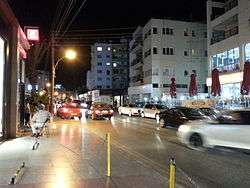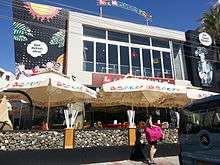Dereboyu Avenue

Dereboyu Avenue (Turkish: Dereboyu Caddesi), also known simply as Dereboyu and officially as Mehmet Akif Avenue (Turkish: Mehmet Akif Caddesi), is the busiest avenue in North Nicosia,[1] as well as its centre of entertainment. The region of Dereboyu is also understood as extending to the neighbouring Osman Paşa Avenue.[2]
The avenue extends into the Green Line, and the part of it under Turkish Cypriot control has a length of 1,600 metres, with two lanes.[3] The Nicosia Marathon's route passes through the avenue.[4] The avenue hosts bars and restaurants,[5] as well as occasional shopping festivals and concerts[6] and the annual Nicosia Carnival.[7] It is also used as a site for protests.[8]
History


British rule
It was known as "Shakespeare Avenue" during British rule.[9] Older generations referred to the avenue as "Mehmet Akif Avenue", but to describe it, the phrase "dere boyundaki cadde" ("the avenue along the river") was used as it lies along the Pedieos River.[10] The British administration built an elevated road, named "Irish Bridge", from the avenue across the river, but the road was flooded during winter.[11] The Cyprus Government Railway track from Morphou to Nicosia passed through the avenue. The area was known as "Tabakhane" ("tannery") or "Tabana" in the first half of the century as the tannery was located in the avenue, next to the river where a plantation now exists, having been moved there from the Tabakhane quarter of the walled city in the 19th century by the British administration. Haşmet Muzaffer Gürkan described a "pervading foul odor" in the avenue, where there were "no signs of life" apart from a few dairy farms and the tannery before the 1950s. In 1953, as the Köşklüçiftlik quarter expanded into the avenue and the first houses were built, the tannery was moved to a village. The railway track was also dismantled in 1952, leaving behind a steel bridge and a long strip of land that was then converted to a park.[12]
In 1960, Public Instrument No. 162 of the British administration declared that the widening, realigning and development of the avenue was in public interests and would be undertaken.[13] The name of the street was officially changed later because it was "a remnant of the British colonial period".[14]
Transformation into an entertainment centre
The avenue has become a centre of entertainment and nightlife since the 1990s.[5] Before the development of the avenue, youths living in North Nicosia went to Kyrenia for similar entertainment. At first, the development of the avenue was hindered by a lack of space, as the restaurants could use the open space available in the summer but the space available winter was not sufficient. This led to the restaurants having to reduce their number of personnel in the winter. To solve the problem, a deal was struck by the Nicosia Turkish Municipality and the owners, according to which restaurants could set up portable partitions without building anything. However, in time, some businesses abused this permission.[15]
When Kutlay Erk was the mayor of the Nicosia Turkish Municipality, the sculpture of a Medoş tulip, endemic to Cyprus, was unveiled in the avenue.[16]
In 2011, there was a decrease in the interest of the public in the avenue, as the country was stricken by recession. However, shop owners claimed that issues such as traffic and safety due to drunk youths and occasional gangs also played a role in the decline in the business.[17] In 2013, a roundabout at the junction with the Osman Örek Avenue was restructured.[18]
Infrastructure and development
As of 2011, there were no minibus stops on the avenue.[17] In 2014, Mehmet Harmancı, the mayor of North Nicosia, stated that out of 57 businesses in the area, 26 were actively violating the city planning policy. There were problems with waste management in the region, and there are plans of building underground waste disposal centres. The issue of parking is also an important one, according to Harmancı, there are 140 parking places along the road and a project to establish automated parking machines is under consideration. It has been proposed that the plantation of the Ministry of Agriculture could be used as a car park or a public green space, but there are bureaucratic roadblocks against these proposals.[2] In 2015, the municipality announced that a new car park for 250 cars would be opened next to the river to solve the problem of parking.[19]
In 2014, Kadri Fellahoğlu, then the mayor of North Nicosia, announced that the Turkish Cypriot military had granted the permission to build a parallel road through the military zone on the other bank of the river to ease the traffic in Dereboyu.[20] It was then announced that after the building of the new road, the traffic in Dereboyu would become unidirectional, and new parking lots would be built across the river, as part of an extensive project of environmental restructuring.[21] In 2015, the entrance to some of the roads branching from Dereboyu was banned to ease the traffic.[22]
See also
| Wikimedia Commons has media related to Dereboyu. |
References
- ↑ "Yeni uygulama 23 Şubat’ta devrede" (in Turkish). Haber Kıbrıs. Retrieved 12 March 2015.
- 1 2 "Harmancı Dereboyu esnafını dinledi" (in Turkish). Yeni Düzen. 5 September 2014. Retrieved 12 March 2015.
- ↑ Mehmet Akif Avenue in Google Earth
- ↑ Lefkoşa maratonu yapıldı (Kıbrıs Postası)
- 1 2 Dereboyu’na yakışmadı (Kıbrıs)
- ↑ Gençler coşacak (Kıbrıs)
- ↑ "Dereboyu 'Lefkoşa Karnavalı' ile renklenecek.." (in Turkish). Ekonomi Kıbrıs. Retrieved 22 March 2015.
- ↑ KTOEÖS ve KTÖS, Lefkoşa sokaklarında meşaleli yürüyüş gerçekleştirdi (Kıbrıs Postası)
- ↑ Keshishian, Kevork K. (1978). Nicosia: Capital of Cyprus Then and Now, Attached map, The Mouflon Book and Art Centre.
- ↑ Gündüz, Erdinç. "Dereboyu..." (in Turkish). Kıbrıs Postası. Retrieved 12 March 2015.
- ↑ "Lefkoşa’da sel baskınları ve Kanlıdere" (in Turkish). Yeni Düzen. Retrieved 12 March 2015.
- ↑ Gürkan, Haşmet Muzaffer. Dünkü ve Bugünkü Lefkoşa (in Turkish) (3rd ed.). Galeri Kültür. p. 142. ISBN 9963660037.
- ↑ The Cyprus Gazette. British Administration in Cyprus. 1960. pp. 148, 187. Retrieved 12 March 2015.
- ↑ "‘Menfaat’ değil ‘adalet’ isteyenler - Shakespeare sokağı" (in Turkish). Yeni Düzen. Retrieved 12 March 2015.
- ↑ Erk, Kutlay. "Lefkoşa Konuları" (in Turkish). Yeni Düzen. Retrieved 12 March 2015.
- ↑ "Köprüden geçti gelin...". Kibris.net. Retrieved 12 March 2015.
- 1 2 "Dereboyu markalaştırılmalı" (in Turkish). Haber Kıbrıs. Retrieved 12 March 2015.
- ↑ "Şehir Planlama Dairesi 1Ocak – 31 Aralık 2013 Faaliyetleri" (PDF) (in Turkish). TRNC City Planning Department. Retrieved 12 March 2015.
- ↑ "Yeni yol için proje yarışması düzenlenecek". Kıbrıs. Retrieved 12 March 2015.
- ↑ "Dereboyu için trafik açılımı" (in Turkish). Yeni Düzen. Retrieved 12 March 2015.
- ↑ "LTB’den Dereboyu’na yeni yol müjdesi" (in Turkish). Yeni Düzen. Retrieved 12 March 2015.
- ↑ "Dereboyu'nda sağa dönüşler yasak" (in Turkish). Kıbrıs. Retrieved 12 March 2015.
Coordinates: 35°11′26″N 33°20′56″E / 35.1905°N 33.3489°E